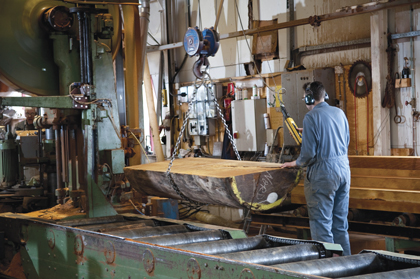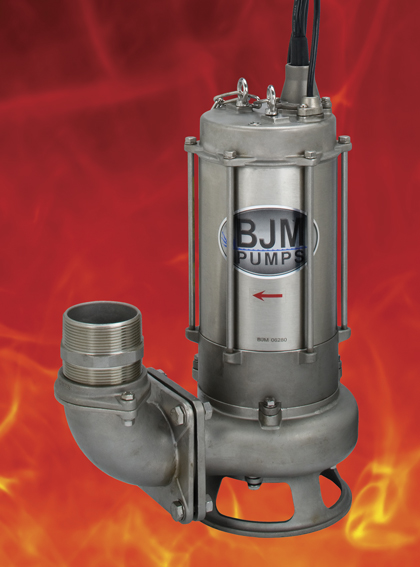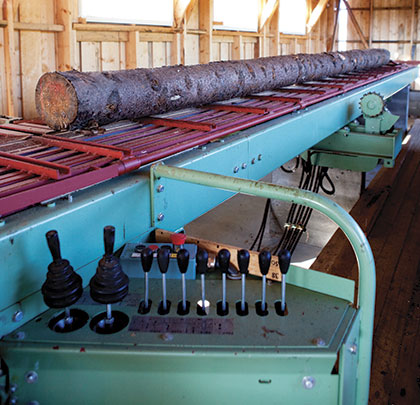Modern sawmills are a far cry from their early predecessors, although the basic need for lumber has not changed. Today’s sawmills are massive, sophisticated facilities. Many of the processes are automated and computerized. Some use lasers to measure the wood before cutting, ensuring the maximum use of each log. And nothing goes to waste. Bark is ground for landscaping, sawdust is pressed into particle board or pellets for wood stoves. Wood chips may be ground and used for paper or as fuel to heat drying kilns. Some sawmills use their waste for co-generation facilities that power the operation and send extra energy to the grid.
THE CHALLENGE
After trees are felled and transported to a sawmill, they are cut to standardized dimensions. This green wood is then dried to prevent rotting, warping, and splitting and to allow the wood to shrink. Wood can be dried in a variety of ways, but West Fraser’s Leola sawmill uses a kiln to dry the wood down to a moisture content of between 8 and 18 percent.
The green wood is packaged and then loaded onto kiln track cars. The packs are approximately 24 feet tall and the lumber sizes range from 2-by-4 up to 2-by-12, and are anywhere from 8 to 20 feet long. The kiln is approximately 125 feet long with two tracks moving lengthwise in opposite directions, explained Leola’s maintenance manager, Happy Stroud. Over the course of 12 to 14 hours the wood is pushed through the kiln, going in as green wood on one end and coming out as dry wood on the other.
The kiln is heated by steam to temperatures up to 180 degrees Fahrenheit (82 degrees Celsius). As the lumber dries, condensation is formed. The resulting acidic liquid wicks off the lumber and is collected in one of two pits at either end of the kiln. The collected liquid is pumped back to the power house where it’s filtered for reuse.
The condensation flowing into the pits carries with it bits of wood, bark, and sand, which, along with the hot, acidic water, creates a challenging environment for pumps. Until recently, the Leola mill had been using self-priming centrifugal pumps in its two kilns, but they were easily clogged and had to be replaced about every two months, said James Reid, a sales rep for Arkansas Industrial Machinery, a supplier to the Leola plant.

THE SOLUTION
Reid and his fellow rep Barry Morgan recommended BJM’s Fahrenheit stainless steel shredder pumps as a solution to the problem. The pumps were recommended for three important reasons Morgan says:
- The stainless steel can handle the acidic water,
- The Fahrenheit motor is designed to withstand high temperatures, and
- The pump’s shredding action can process and clear out the pieces of wood and other particles instead of letting them build up in the bottom of the pit.
Another advantage of the Fahrenheit pumps is they sit down in the pit and push the liquid and shredded material up and out of the pit. The previous pumps sat outside the pit and had to pull the condensate up. Not only was this configuration a problem because of the debris that collected in the pits, but the high temperature of the water also caused problems.
“Hot liquid tends to flash off when you’re pulling it up the self-priming pipe,” Morgan says. He explains that hot water flashes off at a faster rate because of the heat it already has, but when you put it under a vacuum to pull it up a pipe and it flashes the pump loses prime, has to re-prime itself, and can never pull all of the fluid out.
“These shredder pumps sit in the bottom of the pit and can push the liquid out instead of having to suck it up in a straw,” he adds.
Another advantage of the Fahrenheit pump is its unique Seal MinderTM technology.
“It has two seals on it,” explains Reid. “If a seal fails an alarm will go off. That way you’ll know that first seal has failed and you can pull the pump and repair it without it breaking through the second seal, which would destroy the motor. It gives them a warning before it totally fails.”
The alarm is attached to the control panel. If the first seal fails, it’s easily replaced.
“It improves the reliability of the equipment for the maintenance crew and for the mill,” Morgan adds.
Other features that make the Fahrenheit pump ideal for this type of job are that the pumps have non-clog impellers designed for high volume and lift performance. All wear and “wet” parts such as impeller, wear-plate, oil housing, pump-housing, and inner pump top are made of Cast 316 stainless material. The elastomers such as o-rings, lip seals, and gaskets are made of reliable FKM.

THE RESULT
“There haven’t been any issues with them so far,” says Stroud. Reid concurs, saying “So far they’re doing wonderful.”
And the success of the pumps at this mill has created confidence in them elsewhere.
“It seems like I’ve hit a trend in that I’m also selling this same pump to other paper mills and people that have work pits,” Reid concludes.
The reliability and sustainability of BJM’s Fahrenheit pumps fits well with the West Fraser corporate culture. ◆
For More Information:
Mike Bjorkman is vice president of BJM Corp. and has more than thirty years of experience in the pump industry. He serves as director of marketing and IT for BJM Pumps, LLC and All Test Pro, LLC. Both companies are subsidiaries of BJM Corp. Mike can be reached at 860.399.5937. BJM Pumps, established in 1983, supplies electrical submersible pumps to industrial and municipal markets throughout the United States, Canada, and South America. For more information, visit www.bjmpumps.com.
____________________________________________
MODERN PUMPING TODAY, March 2016
Did you enjoy this article?
Subscribe to the FREE Digital Edition of Modern Pumping Today Magazine!
![]()


